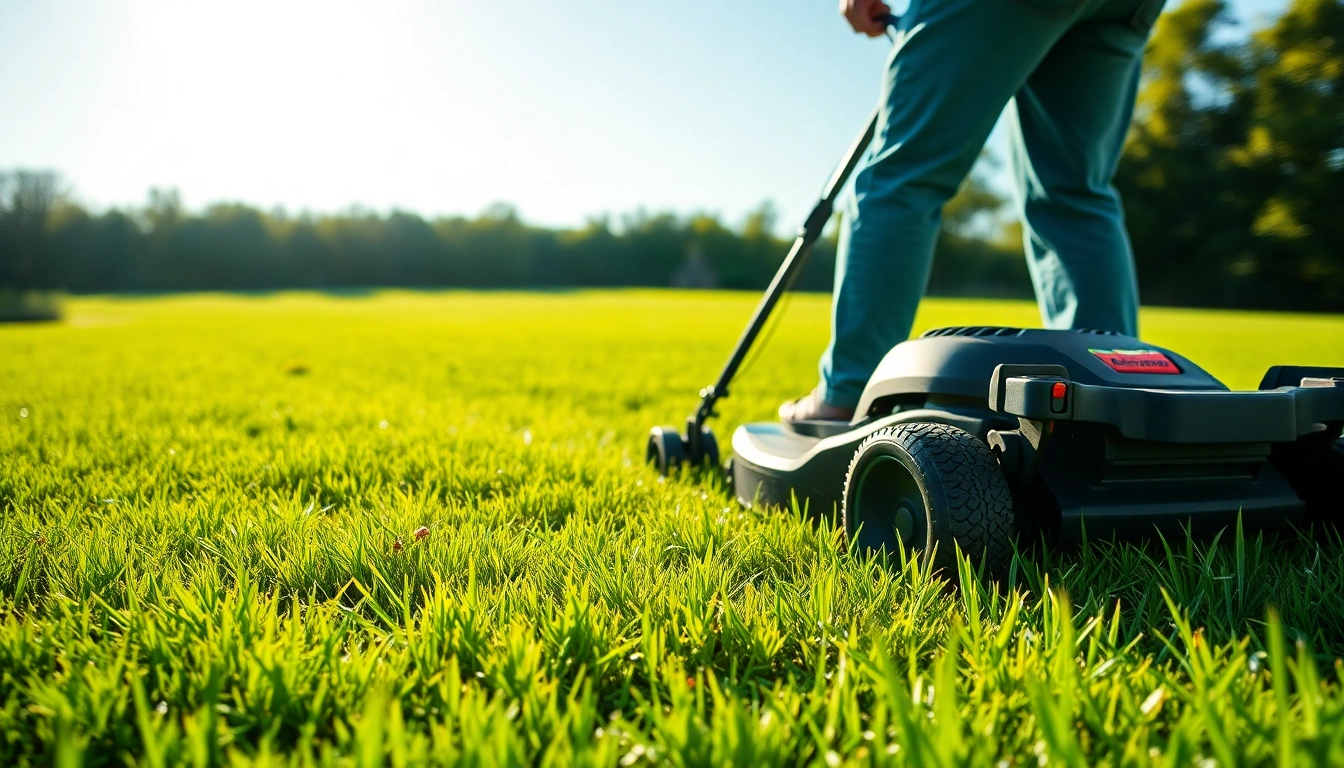Understanding Lawn Mowing Basics
What is Lawn Mowing?
Lawn mowing is the process of cutting grass to a specified height using specialized equipment, primarily lawnmowers, to maintain a neat and visually appealing lawn. This practice is integral to lawn care as it promotes healthy grass growth, contributes to overall lawn aesthetics, and can help prevent lawn diseases. Regular lawn mowing not only enhances the visual appeal of residential and commercial properties but also facilitates the growth of robust grass roots by encouraging horizontal spread.
Benefits of Regular Lawn Mowing
Regular lawn mowing offers a multitude of benefits, both aesthetic and practical:
- Enhanced Visual Appeal: A well-mown lawn is inviting and enhances property curb appeal.
- Healthy Grass Growth: Regular cutting promotes thicker and healthier grass since it stimulates lateral growth.
- Weed Management: Keeping grass at an optimal height prevents weeds from thriving by reducing light penetration to the soil.
- Pest Control: A trimmed lawn eliminates hiding spots for pests and insects, thus promoting a healthier ecosystem.
- Soil Health: Mowing fosters better aeration, which aids root development and nutrient uptake.
Choosing the Right Equipment for Lawn Mowing
Selecting the right lawn mowing equipment is crucial for effective lawn maintenance. Here’s a brief overview of commonly used types:
- Reel Mowers: Ideal for small, flat lawns, these manual mowers cut grass in a scissor-like motion.
- Rotary Mowers: The most common type for residential lawns, using a rotating blade to cut grass. They can be powered by gas or electricity.
- Self-Propelled Mowers: Perfect for large lawns, these mowers move themselves forward, requiring less physical effort from the user.
- Robotic Mowers: These modern solutions automate the mowing process, ideal for those looking for convenience.
Techniques for Effective Lawn Mowing
Proper Cutting Heights for Different Grass Types
The optimal cutting height varies for different grass types. Not understanding this aspect can lead to scalping the lawn or leaving it too tall, which can promote weed growth. Here are some general guidelines:
- Bermudagrass: 1-2 inches
- Buffalograss: 2-3 inches
- Bluegrass: 2-3 inches
- Fescue: 3-4 inches
Best Practices for Lawn Mowing Patterns
Varying the mowing pattern not only enhances the lawn’s appearance but also helps the grass grow upright. Suggested patterns include:
- Vertical Stripes: Mow in rows from one edge to the other to create a striped effect.
- Circular Patterns: This technique is effective for smaller lawns and helps to address uneven terrain.
- Diagonal Cuts: Provides a fresh look and allows for better coverage.
Timing Your Lawn Mowing for Optimum Health
Understanding when to mow your lawn is as important as how often. Ideally, lawns should be mowed when the grass is dry, typically late in the afternoon or early evening. This prevents clumping of cut grass and ensures a clean cut.
Maintaining Lawn Health Post-Mowing
How to Properly Clean and Maintain Lawnmowers
A well-maintained lawnmower performs better and extends its life. Key maintenance tasks include:
- Blade Sharpening: Sharp blades slice grass cleanly, reducing lawn stress.
- Regular Cleaning: Remove grass clippings and debris after each use to prevent rust and damage.
- Oil Changes: Change the oil as per manufacturer recommendations to keep the engine running smoothly.
Signs Your Lawn Needs Extra Care After Mowing
Post-mowing care is essential for maintaining a healthy lawn. Look for indications that your lawn needs attention:
- Yellow Patches: Often signifies over-mowing or nutrient deficiency.
- Thinning Grass: May imply a need for aeration or more sunlight.
- Weed Overgrowth: Indicates a need for more mowing or enhanced weed management strategies.
Seasonal Lawn Care Adjustments
As seasons change, so do the requirements for lawn care. During summer, increase the mowing frequency while lowering the blade height. In contrast, during the fall, transition into a lower frequency to allow grass to thicken for winter.
Common Lawn Mowing Mistakes to Avoid
How Over-Mowing Affects Grass Growth
Over-mowing can severely damage your lawn by depriving grass of essential nutrients. Allowing the grass to grow to the appropriate height before mowing is crucial for effective growth and resilience.
Ignoring Weather Conditions Before Mowing
Mowing after a heavy rain can lead to clumping and tearing of grass, which affects its health. Always check weather conditions, ensuring the lawn is dry and suitable for mowing.
Neglecting Lawn Edges and Borders
Failing to maintain edges detracts from the overall appearance of the lawn. Take time to trim borders to prevent grass from spreading into flower beds or sidewalks, boosting curb appeal.
Choosing Professional Lawn Mowing Services
When to Hire a Lawn Mowing Service
Hiring a lawn service may be beneficial when:
- The lawn is too large to manage independently.
- You lack the time or equipment required for effective mowing.
- You are unsure of proper mowing techniques and timing.
Evaluating Quality and Pricing of Lawn Care Services
To determine whether a lawn care service fits your needs, consider their Service offers and customer reviews. The average price for lawn mowing services generally ranges between $30 and $60 per visit, depending on lawn size and location.
Questions to Ask Before Hiring Lawn Care Professionals
Before engaging a lawn care service, ask important questions such as:
- What services do you provide besides lawn mowing?
- Can you provide references or customer reviews?
- What is your pricing structure?
- How do you maintain quality in your services?
Understanding the fundamentals of lawn mowing, the techniques involved, and the best practices will ensure a healthier and more vibrant lawn. Following the guidelines and tips outlined in this comprehensive guide not only enhances the aesthetic appeal of your turf but also contributes to long-term lawn health and sustainability.
